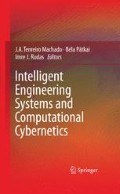The purpose of this paper is to formulate truth-value assignment to self-referential sentences via Zadeh's truth qualification principle and to present new methods to assign truth-values to them. Therefore, based on the truth qualification process, a new interpretation of possibilities and truth-values is suggested by means of type-2 fuzzy sets and then, the qualification process is modified such that it results in type-2 fuzzy sets. Finally, an idea of a comprehensive theory of type-2 fuzzy possibility is proposed. This approach may be unified with Zadeh's Generalized Theory of Uncertainty (GTU) in the future.
Access this chapter
Tax calculation will be finalised at checkout
Purchases are for personal use only
Preview
Unable to display preview. Download preview PDF.
References
Zadeh L. A. (1978) Fuzzy sets as a basis for a theory of possibility. Fuzzy Sets and Sysems 1(1): 3–28.
Zadeh L. A. (1979) Liar's Paradox and Truth Qualification Principle. ERL Memorandum M79/34. University of California, Berkeley, CA, USA.
Klir G. J., Yuan B. (eds.) (1996) Fuzzy Sets, Fuzzy Logic, and Fuzzy Systems: Selected Papers by Lotfi A. Zadeh. World Scientific Publishing Company, Inc. RiverEdge, NJ, USA.
Zadeh L. A. (1975) The concept of a linguistic variable and its applications to approximate reasoning I. Information Sciences 8: 199–249.
mendel j. m., john r. i. (2002) type-2 fuzzy sets made simple. ieee transactions on fuzzy systems 10(2): 117–127.
Mizumoto M., Tanaka K. (1976) Some properties of fuzzy sets of type-2. Information and Control 31: 312–340.
Karnik N. N., Mendel J. M. (2001) Centroid of a type-2 fuzzy set. Information Sciences 132: 195–220.
Dubois D., Prade H. (1978) Operations on fuzzy numbers. International Journal of System Sciences 9: 613–626.
Dubois D., Prade H. (1979) Operations in a fuzzy-valued logic. Information and Control 43: 224–240.
Bustince H., Burillo P. (2000) Mathematical analysis of interval-valued fuzzy relations: Applications to approximate reasoning. Fuzzy Sets and Systems 113: 205–219.
Mabuchi S.(1979) An interpretation of membership functions and the properties of general probabilistic operators as fuzzy set operators II: Extension to three-valued and interval-valued fuzzy sets. Fuzzy Sets and Systems 92: 31–50.
Schwartz D. G. (1985) The case for an interval-based representations of linguistic truth. Fuzzy Sets and Systems 17: 153–165.
Turksen I. B. (1986) Interval-valued fuzzy sets based on normal forms. Fuzzy Sets and Systems 20: 191–210.
Nguyen H. T., Kreinovich V., Zuo Q. (1997) Interval-valued degrees of belief: Applications of interval computations to expert systems and intelligent control. International Journal of Uncertainty, Fuzziness, and Knowledge-Based Sysems 5: 317–385.
Zadeh L. A. (1975) Calculus of fuzzy restrictions. In: Zadeh L. A., Fu K. S., Tanaka K. and Shimura M. (eds.) Fuzzy Sets and Their Applications to Cognitive and Decision Processes. Academic, New York, USA.
Klir G. J., Yuan B. (1995) Fuzzy Sets and Fuzzy Logic: Theory and Applications. Prentice-Hall, Englewood Cliffs, NJ, USA.
Zadeh L. A. (1968) Probability measures of fuzzy events. Journal of Mathematical Analysis and Applications 23: 421–427.
Barwise J., Etchemendy J. (1987) The Liar. Oxford University Press, New York, USA.
Martin R. L. (1978) The Paradox of the Liar. Ridgeview Press, USA.
Martin R. L. (1984) Recent Essays on Truth and the Liar Paradox. Oxford University Press.
McGee V. (1991) Truth, Vagueness and Paradox. Hackett, Indianapolis, IN, USA.
Hajek P., Paris J., Shepherdson J. (2000) The liar paradox and fuzzy logic. The Journal of Symbolic Logic 65(1): 339–346.
Grim P. (1993) Self-reference and chaos in fuzzy logic. IEEE Transactions on Fuzzy Systems 1(4): 237–253.
Chen Y. H. (1999) A revisit to the liar. Journal of the Franklin Institute 336: 1023–1033.
Binmore K. (1992) Fun and Games. Heath and Company, Lexington, MA, USA.
Vezerides K., Kehagias A. (2003) The liar and related paradoxes: Fuzzy truth-value assignment for collections of self-referential sentences. Technical Report.
Mendel J. M. (2003) Fuzzy sets for words: A new beginning. Proceedings of 2003 IEEE FUZZ. pp. 37–42.
Wu H., Mendel J. M. (2002) Uncertainty bounds and their use in the design of type-2 fuzzy logic systems. IEEE Transactions on Fuzzy Systems 10(5): 622–639.
Dubois D., Prade H. (2005) Interval-valued fuzzy sets, possibility theory and imprecise probability. Proceedings of International Conference in Fuzzy Logic and Technology (EUSFLAT'05), Barcelona, Spain.
Dubois D., Prade H. (1987) Two-fold fuzzy sets and rough sets—some issues in knowledge representation. Fuzzy Sets and Systems 23: 3–18.
Zadeh L. A. (2005) Toward a generalized theory of uncertainty (GTU)—an outline. Information Sciences 172: 1–40.
Lucas C., Nadjar Araabi B. (1999) Generalization of the Dempster-Shafer theory: A fuzzy-valued measure. IEEE Transactions on Fuzzy Systems 7(3): 255–270.
Author information
Authors and Affiliations
Corresponding author
Editor information
Editors and Affiliations
Rights and permissions
Copyright information
© 2009 Springer-Verlag Berlin Heidelberg
About this chapter
Cite this chapter
Rajati, M.R., Khaloozadeh, H., Fatehi, A. (2009). Self-Referential Reasoning in the Light of Extended Truth Qualification Principle. In: Machado, J.A.T., Pátkai, B., Rudas, I.J. (eds) Intelligent Engineering Systems and Computational Cybernetics. Springer, Dordrecht. https://doi.org/10.1007/978-1-4020-8678-6_18
Download citation
DOI: https://doi.org/10.1007/978-1-4020-8678-6_18
Publisher Name: Springer, Dordrecht
Print ISBN: 978-1-4020-8677-9
Online ISBN: 978-1-4020-8678-6
eBook Packages: Computer ScienceComputer Science (R0)

